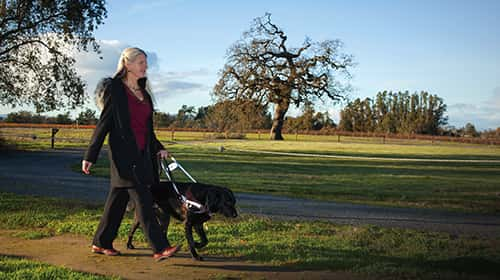At some point in life, I think most everyone wonders what it would be like to be blind: You turn off the lights and try to navigate around your house or close your eyes and try to pour a bowl of cereal and milk. Even the simplest of tasks becomes time-consuming and tricky. The idea of living in darkness, day-after-day, feels overwhelming, and it’s easy to imagine that becoming blind is the beginning of a swift downward spiral—the start of countless hours of sitting alone, depressed and depending on other people for every single little thing.
So it came as a surprise to meet so many independent and happy blind folks while researching this article. Sure, there are always those few superhumans who chew up challenges and spit out motivational posters, but that’s not who I’m talking about here. I’m talking about folks like me, who find the prospect of frying up some eggs with their eyes closed a bit too daunting. Yet, when these people became blind or visually impaired, they found that continuing on with meaningful lives wasn’t nearly as stupefying as they’d imagined it would be.
“People come in here depressed, because they think life is over with diminished sight,” says Dan Needham, CEO of the Earle Baum Center for the Blind in Sonoma County. “After a while, they come through to the other side and realize they can do just about anything they want—they can lead a very fulfilling life. That’s my favorite part of the job, to witness that transformation.”
Learning life strategies
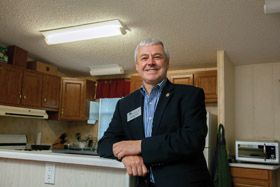 The Earle Baum Center, like several other nonprofits in the North Bay, is committed to helping the blind and visually impaired live productive and joyful lives. Clients come to the facility to learn adaptive skills for everyday life, such as how to travel safely and prevent falls, and find out what helpful technology is available and how to use it. They also find a community of people going through similar challenges who they can learn from and socialize with.
The Earle Baum Center, like several other nonprofits in the North Bay, is committed to helping the blind and visually impaired live productive and joyful lives. Clients come to the facility to learn adaptive skills for everyday life, such as how to travel safely and prevent falls, and find out what helpful technology is available and how to use it. They also find a community of people going through similar challenges who they can learn from and socialize with.
The nonprofits draw from new technological breakthroughs in addition to generations of accumulated knowledge about the many daily tweaks it takes to do life a little bit differently. How do you know if you’re handing over a $1 bill or a $100 dollar bill? How do you walk down buckled sidewalks safely and how do you cross the street? How do you make sure your clothes match? There are tested techniques and tips for just about everything. Finding it difficult to squirt toothpaste on that toothbrush? Rethink it: Cut to the chase and just squirt a little in your mouth and start brushing. Or let’s say you find a note on your door that you can’t read. There’s an app for that; take a picture of the page with your smartphone and your phone reads you the message (if the note is machine readable). “The new technology is amazing,” Needham says. “Jeff Harrington, our manager of assistive technology, is blind, and he says, ‘It’s never a really good time to go blind, but if you have to, now’s the best time in history to do it.’”
There’s a world of information and techniques and technology that can help the visually impaired lead a life of very few restrictions. Organizations such as the Earle Baum Center have the “knowledge, training, facilities and the passion to help our community,” Needham adds. “But, what we always need is more funding. A joyful, meaningful lifestyle is readily accessible for the blind. But, trying to figure out all these skills on their own—especially without having the benefit of sight, and while they’re already grieving their loss—well, that’s overwhelming.” That small amount of funding can be the difference between someone contributing to society and leading a happy, fulfilling life, and someone living the kind of restricted life we fear when we turn off the lights and let our imaginations run amok.
With a $1.5 million annual budget, the center receives some federal funding and fees for services, But most of the money from private donations. Businesses help out by sponsoring for the annual Earle Fest fundraiser (see sidebar). During the United Way’s Day of Caring, a group from Keysight Technologies comes over to do construction, clean up and repairs at the facility. Long before becoming the CEO at the center, Needham was an engineer at Agilent Technologies, the company from which Keysight spun off in 2015. “Every year for the Day of Caring, I feel like my friends are coming over to help. It’s great! Between Keysight and service organizations such as The Lions Club and Rotary, we get so much done here that we would have had to pay for otherwise.”
New funding challenges
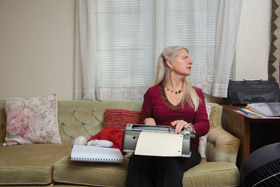 These days, the center could use some additional help and donations, because the federal government recently cut funding for life skills classes to future clients who are classified as “homemakers.”
These days, the center could use some additional help and donations, because the federal government recently cut funding for life skills classes to future clients who are classified as “homemakers.”
“Let’s say someone is taking care of all the work that goes along with being a homemaker, and maybe taking care of the children, and perhaps even taking care of elderly parents,” Needham says with a shake of his head. “Now let’s say they lose their sight. If they get the training, information and help they need, they can continue on with their life, including taking care of the household. But, if they don’t get that help to adjust to a new way of life, then the family will nee to take care of them. There are all kinds of societal costs to that—family members late to work or not being able to get in at all—not to mention a whole new level of stress and illness.
“What’s more, if a person doesn’t get the training they need to move around safely, then falling down and breaking a hip is more common,” he adds. “The cost to society for hospitalization, surgery and treatment, is far greater than the cost of teaching them the needed skills.”
For people living alone, losing their sight without access to learning the skills needed to take care of themselves could easily lead to institutionalization. “Once again, that’s a much bigger cost to society than simply teaching them the skills,” Needham says. “On top of that, these individuals would no longer be able to lead an independent life, in their own homes—the home they worked to have.”
Moments of magic
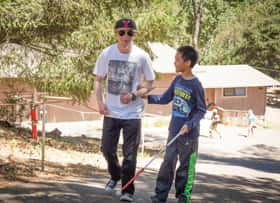 Needham walks me through the campus-like setting of the Earle Baum Center, toward the small home where clients learn skills including cooking, cleaning, doing the laundry, paying the bills and more. A couple of women are taking a walk on the surrounding paths, their canes skimming the ground in front. They pause for a second to chat. “What a lovely day,” one comments. “Warm breeze and so many birds singing—just lovely.” They smile and continue on. Needham and I keep walking, soon passing a gurgling fountain. “That’s not a fountain,” he says with a laugh. “That’s an auditory location device. It lets people know they’re by the office.”
Needham walks me through the campus-like setting of the Earle Baum Center, toward the small home where clients learn skills including cooking, cleaning, doing the laundry, paying the bills and more. A couple of women are taking a walk on the surrounding paths, their canes skimming the ground in front. They pause for a second to chat. “What a lovely day,” one comments. “Warm breeze and so many birds singing—just lovely.” They smile and continue on. Needham and I keep walking, soon passing a gurgling fountain. “That’s not a fountain,” he says with a laugh. “That’s an auditory location device. It lets people know they’re by the office.”
When we reach the training house, instructor Denise Vancil is harnessing her guide dog, Caesar, in preparation for heading to the rec room to teach a class. A visual rehabilitation therapist and instructor, Vancil teaches the reading-writing of Braille, independent living skills and coordinates a variety of recreational life skills including tap dance, exercise, yoga, birding by ear, ukulele classes, tandem bike rides and more. That way, clients can practice their newfound skills, have some fun and socialize as well.
Vancil, who’s been blind since age 13, has a special fondness for the dance classes. She considered becoming a professional dancer in her youth, but ultimately decided to earn a master’s degree in special education. She’s traveled the world, picking up on the dance styles of the locals. Right before starting her job at the Earle Baum Center, she’d been travelling in Cuba. “ When you dance salsa in the streets of Havana, it’s magical,” she says with a smile.
When I ask her whether blind people can safely live alone or whether they typically need someone around to help them, Vancil answers with infinite patience. There are many blind people who do live alone and are perfectly capable of it, she says. But, there are also many, like her, who live with spouses and children, and who need to take care of their family in addition to themselves. “Short of being a truck driver or maybe a brain surgeon, blind people can do pretty much anything they want to do, especially with a little instruction,” she says.
Light the way
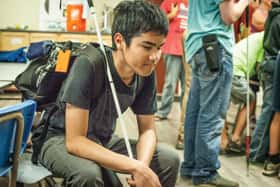 The Earle Baum Center serves individuals in Sonoma, Napa, Lake and Mendocino counties, and LightHouse in Marin County offers similar services. Its main office is located in San Francisco, with a satellite facility in San Rafael. In addition to the usual classes for independent living skills, mobility and technology, the nonprofit runs a popular youth program. Kids throughout the Bay Area take classes and participate outings like river rafting, skiing and rock climbing. LightHouse also owns and manages the Enchanted Hills Camp and Retreat in Napa County.
The Earle Baum Center serves individuals in Sonoma, Napa, Lake and Mendocino counties, and LightHouse in Marin County offers similar services. Its main office is located in San Francisco, with a satellite facility in San Rafael. In addition to the usual classes for independent living skills, mobility and technology, the nonprofit runs a popular youth program. Kids throughout the Bay Area take classes and participate outings like river rafting, skiing and rock climbing. LightHouse also owns and manages the Enchanted Hills Camp and Retreat in Napa County.
Located on 311 acres on Mt. Veeder, Enchanted Hills offers all the usual summer camp opportunities, including riding horses, walking trails, singing campfire songs and putting on skits. “The camp was started in 1950 by a blind woman who went to a similar camp when she was young,” explains Tony Fletcher, director of Enchanted Hills. “There was nothing like it on the West Coast back then, and she vowed to start one. Now, visually impaired children from all over the world come here for the experience.”
This year’s Cycle for Sight fundraiser for the camp will take place Saturday, April 22, and is organized through the Napa Rotary Club. The 50-mile scenic ride goes right by the front entrance of the camp. Sponsorship opportunities for local business are available by contacting the Rotary. Wine vendors provide free tastings after the ride, and riders can raise pledges. A lot of the kids who attend Enchanted Hills Camp join in and ride a tandem bike for shorter rides that take place on the valley floor.
Guidance and support
 Marin County is also headquarters to Guide Dogs for the Blind, the largest guide dog organization in North America and the second largest in the world. The nonprofit, which serves the blind and visually impaired of United States and Canada, operates on a $37 million annual budget and receives no government funding. All of the money comes from donations.
Marin County is also headquarters to Guide Dogs for the Blind, the largest guide dog organization in North America and the second largest in the world. The nonprofit, which serves the blind and visually impaired of United States and Canada, operates on a $37 million annual budget and receives no government funding. All of the money comes from donations.
“I think a large part of the success we’ve had in attracting donations is because we have a very visible mission,” says CEO Christine Benninger. “Our graduates and guide dogs are out in the community all the time, just living life, and people see them. There ‘s something so special and uplifting about seeing that team—witnessing the bond between them—it makes you feel good. I think people want to be a part of it. They want to perpetuate that kind of care and love and hope.”
In addition to individual donations, a number of corporations also contribute to Guide Dogs for the Blind through community benefit programs. “For example, Facebook has this great program where it will match its employees’ donations,” Benninger says, adding that Facebook employees also get a certain amount of paid hours off work so they can volunteer. “I asked my contact at Facebook why they do it and was told that that’s the way businesses attract and hold onto top talent: The younger generation’s leaders are very philanthropic and to get them, companies offer incentives like this.”
Staying social
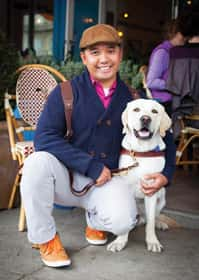 While Guide Dogs for the Blind is one of the largest nonprofits serving the visually impaired, Marin County is also home to one of the smallest.
While Guide Dogs for the Blind is one of the largest nonprofits serving the visually impaired, Marin County is also home to one of the smallest.
“We’re small but we’re full of energy,” says Lillian Dreyer, president of Vision Impaired of Marin. Dreyer had been a busy and successful business owner and a community-minded feminist her entire life. A few years ago, she had an adverse reaction to medication and, over the course of half a day, her sight disappeared. “You’d think it would just go black,” she says, “but it wasn’t like that. It looked like indigo blue cellophane wrap for a few hours. And then it turned black.” After several months, some of her vision returned.
When she lost her sight, Dreyer began attending the classes at LightHouse to get her bearings and learn a new way of living. Afterwards, she decided to join VIM and now serves as the president. “VIM was founded more than 42 years ago by a small group of blind people who sought fellowship,” Dreyer explains. “It’s tough to remain social when you’re visually impaired, so you end up becoming isolated and depressed. VIM offers people the ability to share life’s challenges, receive relevant information and be part of a support network. It just helps to be around people who know what you’re going through. Our oldest member, who’s 96, has been with the organization since the beginning and still leads a support group.”
With an annual budget of about $50,000, VIM organizes support groups, art and dance classes, luncheons and picnics, talking book clubs (including one in Spanish) and more. The nonprofit is funded solely by private donations, with most fundraising done through direct mail, small business sponsorships, personal contact and a few small grants as well as one small estate distribution.
VIM always needs volunteers for driving, reading, office support and luncheons, as well as people to facilitate support groups. “Above all, VIM needs financial help. While most of the operations are covered by volunteers, all the usual costs of being a service business are there, like insurance, phones, part-time office staff, supplies and on and on. Every donation, however small is deeply appreciated,” Dreyer adds. “I don’t know if people fully appreciate what a big difference a small donation can make.
Who Was Earl Baum?
The Earle Baum Center for the Blind used to be the residence of Earle Baum (1896-1986), who lost his sight as a teenager but he continued to work the fields on his family’s farm, doing all the planting and tending and harvesting on his own.
“The only thing he didn’t do was drive the tractor,” says Dan Needham, CEO of the Earle Baum Center. “But, he was the one who would repair it. He wanted to be a journalist, but didn’t go into that career because of his sight. If he’d been alive now and had the tools we have, he could have been a journalist if he wanted to.”
Baum remained on the farm until his death at the age of 90. He instructed that the 18 acres of farmland, just west of Santa Rosa, be developed to service people with impaired vision. He once said, “It’s my hope that the farm will become a place where the blind can work, play and fellowship together instead of shedding bitter tears of frustration on their friends’ shoulders.”
“It’s quite a legacy,” Needham says, “and the community appreciates it. As a society, we’re living longer and longer. And a good many of us will experience some degree of visual impairment as we age. If the local community comes together to makes sure that the center is here to help those who need it, then we’ll also be around to help when they need it.”
earlebaum.org
EarleFest
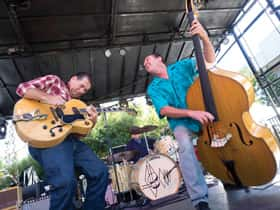 In 2007, then-Earle Baum Center CEO Alan Brenner contacted Bill Bowker at KRSH radio in Santa Rosa about presenting a concert fundraiser for the center. “Alan was a roots music fan, and he felt like it was a music style that wasn’t being represented in the area,” says Bowker, a mainstay at the station and in the local music scene. “I came out to see the property and it’s just beautiful. It was a great venue.”
In 2007, then-Earle Baum Center CEO Alan Brenner contacted Bill Bowker at KRSH radio in Santa Rosa about presenting a concert fundraiser for the center. “Alan was a roots music fan, and he felt like it was a music style that wasn’t being represented in the area,” says Bowker, a mainstay at the station and in the local music scene. “I came out to see the property and it’s just beautiful. It was a great venue.”
Modeled after MerleFest, an annual weekend concert tribute to Doc and Merle Watson that takes place in North Carolina, the first EarleFest featured performances by Chris Hillman with Herb Peterson, and bluesman Otis Taylor. Since that debut, EarleFest has become a well-known and sought-after event in the Americana music genre, bringing new, established and legendary artists to the West Sonoma County facility.
“It’s an amazing festival,” says Dan Needham, president and CEO of the Earle Baum Center for the Blind. “Not only does it bring in much-needed funds, but it’s also just so much fun for everyone involved. Plus, it gets our name out into the community, and it also gets our sponsors’ names out there.”
In 2016, the festival moved from the Earle Baum Center grounds to SOMO Village Event Center in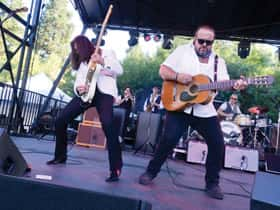 Rohnert Park. The daylong celebration, headlined by singer-songwriter Lucinda Williams and featuring performances by the Mavericks and the Paladins, drew a crowd of more than 1,000 people and raised about $30,000 for the nonprofit.
Rohnert Park. The daylong celebration, headlined by singer-songwriter Lucinda Williams and featuring performances by the Mavericks and the Paladins, drew a crowd of more than 1,000 people and raised about $30,000 for the nonprofit.
“We had a brand and a following but, honestly, the event was getting too big for us—we’re not event producers, we’re a nonprofit for the visually impaired. That’s what we know how to do best,” Needham explains. Bowker and the radio station worked with local producers Second Octave and Notable Talent to move the festival to its new home, a 3,000-seat outdoor venue with a sound and lighting system (powered by clean energy) that was custom designed for its 1,200-square-foot stage. “It’s a great fit,” says Bowker.
EarleFest 2017 will take place in September. For more information, go to earlefest.com.


